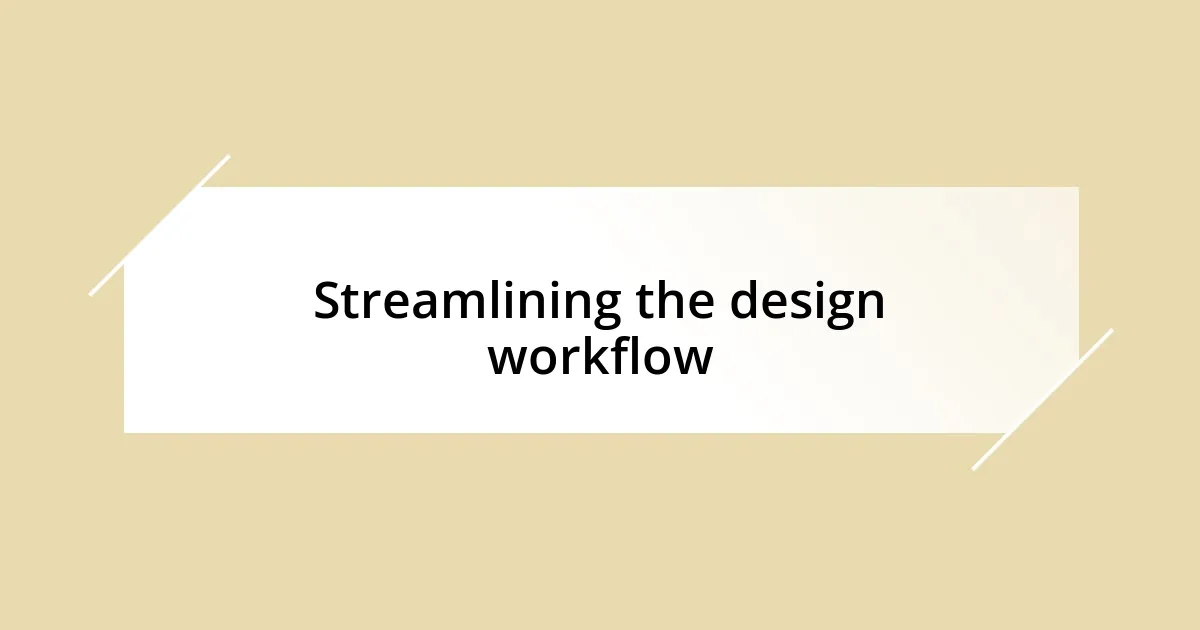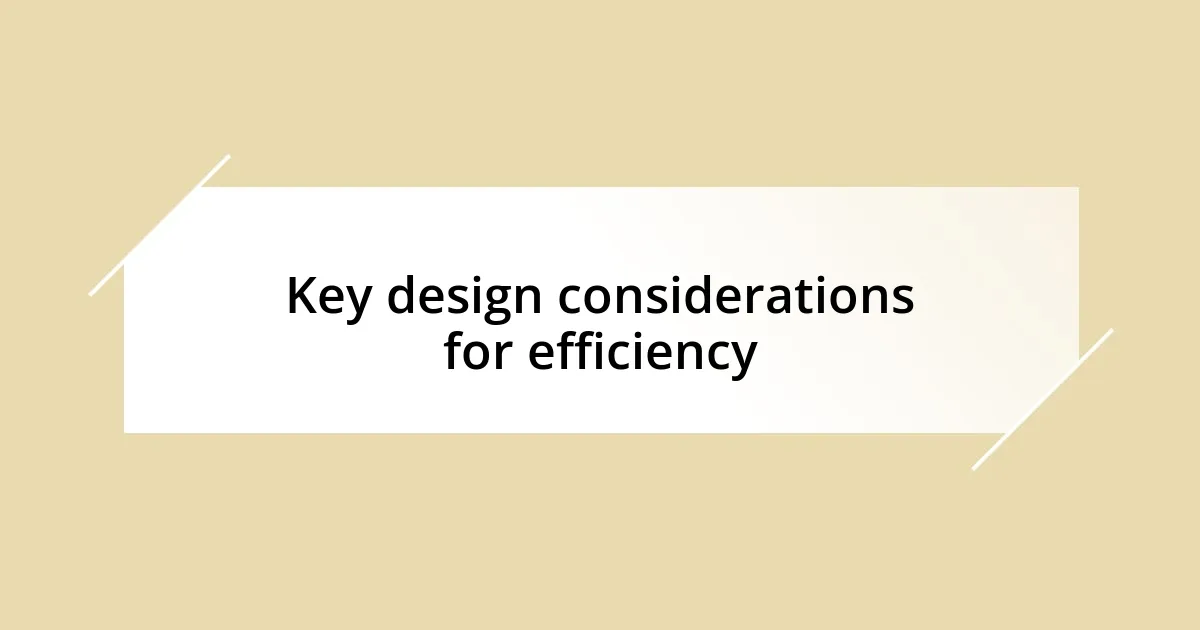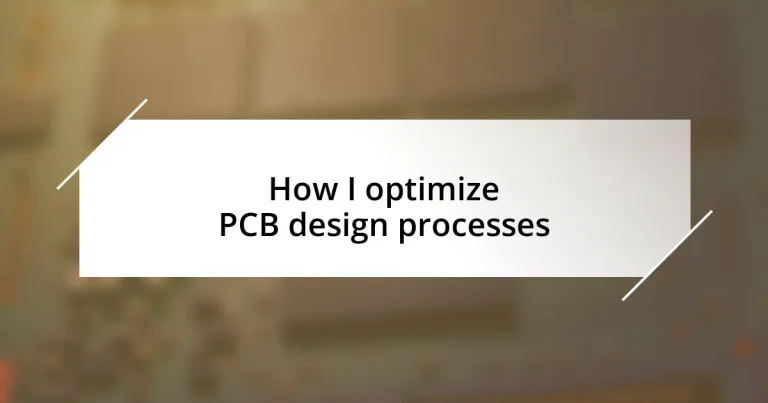Key takeaways:
- Component placement and signal integrity are critical challenges in PCB design that require meticulous attention to detail.
- Utilizing effective design software, like Eagle and Altium Designer, significantly enhances the design process through improved functionality and visualization.
- Streamlining workflows through standardization, templates, and collaboration tools can boost productivity and foster innovation.
- Implementing design rule checks (DRCs) early and tailoring them to specific projects helps prevent costly errors and ensures compliance with design specifications.

Understanding PCB design challenges
When diving into the PCB design process, I often find myself grappling with component placement. It can be a real puzzle! One time, I spent an entire weekend rearranging components, trying to achieve the perfect balance between functionality and manufacturability. Have you ever faced similar challenges? It’s frustrating, but that’s part of the learning curve.
Another major hurdle is managing signal integrity. I remember working on a high-speed project where I underestimated the impact of trace lengths. The moment I realized that my design was introducing noise, it felt like I hit a wall. How often do we overlook the smallest details that can lead to big consequences? A moment of oversight can mean wasted resources and time, and it’s essential to remain vigilant.
Lastly, adhering to regulatory standards can feel like navigating a maze. The requirements often seem endless and convoluted. I’ve had instances where different regulations clashed, creating confusion in my design process. It’s a reminder that while creativity plays a part in PCB design, understanding and complying with these standards is crucial for success. How do you feel about balancing creativity with compliance in your designs?

Effective design software tools
When it comes to PCB design, utilizing effective design software tools can make a world of difference. Personally, I’ve tried several software platforms, and each has its unique strengths and weaknesses. For instance, I recall using Eagle for a project where quick prototyping was essential; its flexibility and extensive libraries saved me hours of searching for the right components. Choosing the right tool often feels like finding a comfortable pair of shoes—it’s all about fit and functionality.
In contrast, I’ve also spent time with Altium Designer, which offers advanced features like 3D visualization that really help in understanding the final product. I remember being amazed when I could literally see how components would interact in real-time, which helped me avoid potential interference issues that I would have missed otherwise. It’s genuinely rewarding when the software complements your design process instead of complicating it.
To help you navigate these tools, I’ve put together a comparison table to highlight some key features and benefits:
| Software | Key Features |
|---|---|
| Eagle | User-friendly, extensive libraries |
| Altium Designer | Advanced 3D visualization, real-time interaction |
| KiCad | Open-source, customizable |
| Autodesk Fusion 360 | ECAD-MCAD integration |

Streamlining the design workflow
Streamlining the design workflow is all about creating a seamless process that minimizes delays and maximizes efficiency. I remember when I started mapping out my workflows and realized how much time I wasted on redundant tasks. Eliminating those bottlenecks not only boosted productivity but made the entire experience more enjoyable. The best part? I found that a well-structured workflow allows for more room to innovate.
Here are some strategies I’ve implemented to make my design workflow smoother:
– Standardization: Developing a consistent naming convention for files and components promotes better organization.
– Template usage: Creating templates for common designs can drastically cut down on setup time.
– Collaboration tools: Utilizing platforms where team members can easily share feedback enhances communication and speeds up revisions.
– Version control: Keeping track of changes ensures I can roll back if something goes awry, providing peace of mind throughout the design process.
– Regular reviews: Scheduling frequent check-ins can help catch potential issues before they escalate, fostering a more proactive approach to design.
Ultimately, these strategies have transformed my workflow from a chaotic flurry of tasks into a more manageable and enjoyable experience. What about you—what tweaks have you made to streamline your own process?

Key design considerations for efficiency
When I think about key design considerations for efficiency, one aspect that stands out is the importance of component placement. During one of my projects, I spent days rearranging components to optimize signal flow, only to realize later that a more compact layout could have reduced costs and board size. It’s fascinating how a little thought behind the arrangement can lead to significant gains—not just in performance but also in overall production time. Have you ever faced similar challenges?
Thermal management is another critical factor that can’t be overlooked. I recall designing a PCB for a device that would run continuously, and I skimped on heat dissipation strategies. As a result, I had to redesign the board after testing when things overheated. That experience taught me that integrating heat sinks or ensuring proper airflow from the outset saves both time and frustration later on. After all, no one wants to create a product that risks failure due to heat!
Lastly, considering expandability during the design phase can significantly enhance long-term efficiency. In one instance, I designed a board with future upgrades in mind, which proved invaluable when my client requested additional functionality months down the line. By embedding options for additional ports and utilizing modular components, I could avoid a complete redesign. This forward-thinking approach not only impressed my client but also made my job easier. How do you integrate future-proofing into your designs?

Implementing design rule checks
Implementing design rule checks (DRCs) has become a cornerstone of my PCB design process. I remember one project where I overlooked the spacing requirements between traces. It wasn’t until a potential error was flagged during the review stage that I appreciated the power of DRCs. They saved me from a costly and time-consuming redesign, ensuring my board met all necessary specifications right from the start. Have you had similar experiences where DRCs caught issues before they escalated?
I’ve also come to realize that defining custom rules tailored to specific projects can make a huge difference. During a high-frequency circuit design, I started incorporating tighter spacing and impedance control checks. The results were phenomenal! Not only did my board performance improve, but those simple adjustments also reduced signal integrity issues. It reminded me just how crucial it is to adapt DRCs to the unique demands of each project. Have you tried implementing custom rules in your designs before?
Another aspect I’ve found impactful is incorporating DRCs early in the design phase. By running checks at different design stages, I can catch discrepancies before they become integral problems. I distinctly recall a time when I identified a prohibited layer stack-up during early checks. This proactive approach significantly decreased the revision cycle and fostered a more confident design process. I can’t stress enough how vital it is to embrace DRCs as a regular practice—what strategies do you use to stay ahead of possible design flaws?

Collaboration in design processes
Collaboration in PCB design processes is essential for driving innovation and efficiency. I remember a project where our team utilized a shared platform for real-time updates. One team member suggested a radical change to a component layout that no one had considered, and it turned out to optimize both performance and manufacturability. Have you ever experienced a moment where collaboration led to an unexpected breakthrough?
In my experience, regular design reviews can significantly enhance collaboration. During a critical phase of a project, I organized weekly meetings that encouraged open discussions about design choices. It wasn’t just a formality; it allowed everyone to voice concerns and share ideas. The feedback I received not only fine-tuned our designs but also fostered a sense of unity and ownership among the team. How often do you hold such reviews, and what impact do you believe they have on your outcomes?
Communication tools like Slack or Trello are invaluable for tracking progress and discussing revisions. There was a time when I relied solely on emails for updates, and it often led to confusion and missed deadlines. Switching to a project management system streamlined our workflow and provided clarity for everyone involved. Have you found that using specific tools enhances your team’s collaboration? From my perspective, adapting to these platforms made a noticeable difference in our productivity and project success.

Continuous improvement and feedback loops
Continuous improvement through feedback loops is an essential component of refining my PCB design processes. I vividly recall a time when a colleague pointed out a minor oversight in my layout during a design review, which ultimately uncovered a potential issue with thermal management. At first, I felt slightly defensive, but that moment transformed my perspective. Embracing feedback allowed me to enhance my designs more profoundly than I imagined possible. Have you ever had a moment where accepting feedback led to a significant upgrade in your work?
I’ve learned that establishing a systematic approach to gather and incorporate feedback can be transformative. For instance, after a project wrapped up, I implemented a debrief session with my team to discuss what went well and what didn’t. It’s an ongoing practice that puts us in a mindset of learning. Reflecting on past projects led to actionable insights that we could apply immediately. How often do you engage in post-project evaluations to uncover valuable lessons?
Iterating on designs based on feedback not only optimizes performance but also cultivates a culture of openness. I once initiated a simple “design suggestion box” in our office, encouraging everyone to propose ideas, no matter how unconventional. The spontaneity of those ideas? Some of them led to innovative tweaks that significantly improved design robustness. When was the last time you felt empowered to share your thoughts in a collaborative setting? Accepting that growth hinges on continuous improvement can really amplify our design capabilities.














